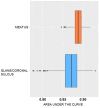The Microbiome Composition of a Man's Penis Predicts Incident Bacterial Vaginosis in His Female Sex Partner With High Accuracy
- PMID: 32903746
- PMCID: PMC7438843
- DOI: 10.3389/fcimb.2020.00433
The Microbiome Composition of a Man's Penis Predicts Incident Bacterial Vaginosis in His Female Sex Partner With High Accuracy
Abstract
Background: We determined the predictive accuracy of penile bacteria for incident BV in female sex partners. In this prospective cohort, we enrolled Kenyan men aged 18-35 and their female sex partners aged 16 and older. We assessed BV at baseline, 1, 6, and 12 months. Incident BV was defined as a Nugent score of 7-10 at a follow-up visit, following a Nugent score of 0-6 at baseline. Amplification of the V3-V4 region of the bacterial 16S rRNA gene was performed on meatal and glans/coronal sulcus swab samples. Majority vote classifier combined the decisions of three machine learning classification algorithms (Random Forest, Support Vector Machine, K Nearest Neighbor). We report the estimate cross-validation predictive accuracy for incident BV based on baseline penile taxa. Results: The incidence of BV was 31% among 168 couples in which the woman did not have BV at baseline: 37.3% if the man was uncircumcised vs. 26.3% if the man was circumcised. Incident BV occurred at 1 month (n = 23), 6 months (n = 20), 12 months (n = 9). The predictive capacity of meatal taxa was high: sensitivity (80.7%), specificity (74.6%), accuracy (77.5%), area under the curve (88.8%). Variable importance ranking identified meatal taxa that in the vagina are associated with BV: Parvimonas, Lactobacillus iners, L. crispatus, Dialister, Sneathia sanguinegens, and Gardnerella vaginalis were among the top 10 most predictive taxa. The accuracy of glans/coronal sulcus taxa to predict incident BV was comparable to meatal taxa accuracy, but with greater variability. Conclusions: Baseline penile microbiota accurately predicted BV incidence in women who did not have BV at baseline, with more than half of incident infections observed at 6- to 12- months after penile microbiome assessment. These results suggest interventions to manipulate the penile microbiome may reduce BV incidence in sex partners, and that potential treatment (antibiotic or live biotherapeutic) will need to be effective in reducing or altering bacteria at both the glans/coronal sulcus and urethral sites (as represented by the meatus). The temporal association clarifies that concordance of penile microbiome with the vaginal microbiome of sex partners is not merely reflecting the vaginal microbiome, but can contribute to it.
Keywords: Kenya; bacterial vaginosis; circumcision; ensemble voting; machine learning; penile microbiome; penile microbiota; synthetic minority oversampling technique.
Copyright © 2020 Mehta, Zhao, Green, Agingu, Otieno, Bhaumik, Bhaumik and Bailey.
Figures



Similar articles
-
Characteristics of Women and Their Male Sex Partners Predict Bacterial Vaginosis Among a Prospective Cohort of Kenyan Women With Nonoptimal Vaginal Microbiota.Sex Transm Dis. 2020 Dec;47(12):840-850. doi: 10.1097/OLQ.0000000000001259. Sex Transm Dis. 2020. PMID: 32773610 Free PMC article.
-
Penile Microbiota and Female Partner Bacterial Vaginosis in Rakai, Uganda.mBio. 2015 Jun 16;6(3):e00589. doi: 10.1128/mBio.00589-15. mBio. 2015. PMID: 26081632 Free PMC article.
-
Bacterial communities in penile skin, male urethra, and vaginas of heterosexual couples with and without bacterial vaginosis.Microbiome. 2016 Apr 19;4:16. doi: 10.1186/s40168-016-0161-6. Microbiome. 2016. PMID: 27090518 Free PMC article.
-
Bacterial vaginosis: drivers of recurrence and challenges and opportunities in partner treatment.BMC Med. 2021 Sep 2;19(1):194. doi: 10.1186/s12916-021-02077-3. BMC Med. 2021. PMID: 34470644 Free PMC article. Review.
-
Characterization of the vaginal microflora in health and disease.Dan Med J. 2014 Apr;61(4):B4830. Dan Med J. 2014. PMID: 24814599 Review.
Cited by
-
Prediction of Smoking Habits From Class-Imbalanced Saliva Microbiome Data Using Data Augmentation and Machine Learning.Front Microbiol. 2022 Jul 19;13:886201. doi: 10.3389/fmicb.2022.886201. eCollection 2022. Front Microbiol. 2022. PMID: 35928158 Free PMC article.
-
Ecology meets reproductive medicine in HIV prevention: the case for geography-informed approaches for bacterial vaginosis in Africa.Front Reprod Health. 2024 Nov 27;6:1431306. doi: 10.3389/frph.2024.1431306. eCollection 2024. Front Reprod Health. 2024. PMID: 39665036 Free PMC article. Review.
-
Treating male partners of women with bacterial vaginosis (StepUp): a protocol for a randomised controlled trial to assess the clinical effectiveness of male partner treatment for reducing the risk of BV recurrence.BMC Infect Dis. 2020 Nov 11;20(1):834. doi: 10.1186/s12879-020-05563-w. BMC Infect Dis. 2020. PMID: 33176727 Free PMC article. Clinical Trial.
-
Molecular Regulatory Mechanisms Drive Emergent Pathogenetic Properties of Neisseria gonorrhoeae.Microorganisms. 2022 Apr 28;10(5):922. doi: 10.3390/microorganisms10050922. Microorganisms. 2022. PMID: 35630366 Free PMC article. Review.
-
Towards a deeper understanding of the vaginal microbiota.Nat Microbiol. 2022 Mar;7(3):367-378. doi: 10.1038/s41564-022-01083-2. Epub 2022 Mar 4. Nat Microbiol. 2022. PMID: 35246662 Free PMC article. Review.
References
Publication types
MeSH terms
Substances
Supplementary concepts
Grants and funding
LinkOut - more resources
Full Text Sources

